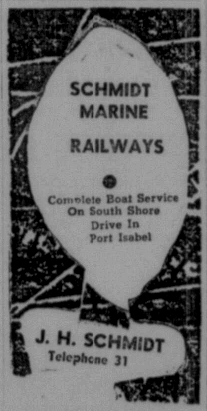
Reprinted from the Port Isabel Press
January 1, 1954, p. 3
Most spectacular coastal highway in America may take shape within the next few years along the Gulf coast, providing another strong link between two friendly nations and a shortcut to Mexico City for most residents of the United States.

The route would reach from Corpus Christi, Texas, to the Mexican capital, following a near sea-level course all the way down the coast to the city of Tuxpan, then swinging abruptly inland.
At no point between Corpus Christi and Tuxpan would the highway stray more than 75 miles from the Gulf, and for 110 miles of the distance it would be routed down narrow, historic Padre Island.
What’s more, it would reduce the driving time from the Texas border to Mexico City to less than 12 hours, chipping the distance to 575 miles and eliminating hazardous and time consuming mountain driving almost completely.
What’s more, it would reduce the driving time from the Texas border to Mexico City to less than 12 hours, chipping the distance to 575 miles and eliminating hazardous and time consuming mountain driving almost completely.
Already two major links in the route are in place, another is taking shape, and a fourth is due to be started in 1954.
The two completed links are causeways trying the north and south ends of Padre Island to the Texas mainland.
The north end causeway – stretching from the Corpus Christi area to the island – was built by Nueces County in 1930 at the cost of $1,700,000.
Now Cameron County is putting the finishing touches on a $2,750,000 causeway between the south tip of Padre and the mainland town of Port Isabel. It is due to be ready for public use in February.
In the works is a 24-mile strip of super-highway tying together the Cameron County causeway and the bridge at the border in Brownsville.
A total of $443,000 already has gone into the construction of the route and $240,000 more is ticketed for use in 1934. The expenditure of an additional $800,000 for future work is expected to round out the job.
The link on which construction is due to start in 1934 is Mexico Highway 25, leading from Brownsville-Matamoros border crossing to Ciudad Victoria, 127 miles to the south.
The route – originally put into use several years ago – is scheduled to be improved by the Mexican government at a cost pegged at $3,488,372. Also planned are three bridges between Matamoros and Ciudad Victoria, two of which would replace ferry crossings and another which would span a deep ravine.
The other links of the scenic route still are in a preliminary state, but they are spurring plenty of conversation and some down-to-earth planning.
An engineering survey – financed jointly by Cameron and Nueces counties – is in progress for a highway reaching the full 110-mile length of Padre Island and connecting the two Padre causeways.
The last leg of the picturesque international route would swing almost directly southward of the Matamoros-Ciudad Victoria highway at the tiny town of Jimenez into the bustling port city of Tampico.
From there it would continue along the coast of Tuxpan, then turn inland toward the Mexican capital.
The route already is being hailed as a natural by many South Texans who see in it an opportunity for the tourist to get the full flavor of both the Texas coast and Mexico.
At the south end of Padre Island is Padre Beach, a multi-million-dollar resort development by John L. Tompkins and company of Corpus Christi that already is showing signs of growing into a year-around international playground that may “out-Miami Miami”.
Besides constructing a causeway between the island and the Texas mainland. Cameron County has begun work on the first of three off-shore parks with $850,000 raised through a county-wide bond issue.
An engineering report – prepared by the firm of Parsons, Brinckerhoff, Hall and MacDonald and accepted by the Cameron County Commissioners Court – calls for other park improvements involving an estimated expenditure of $6,600,000 to be raised through future financing.
The South Padre area is considered by many to be a “must” stopping point for visitors traveling between Brownsville and Mexico City.